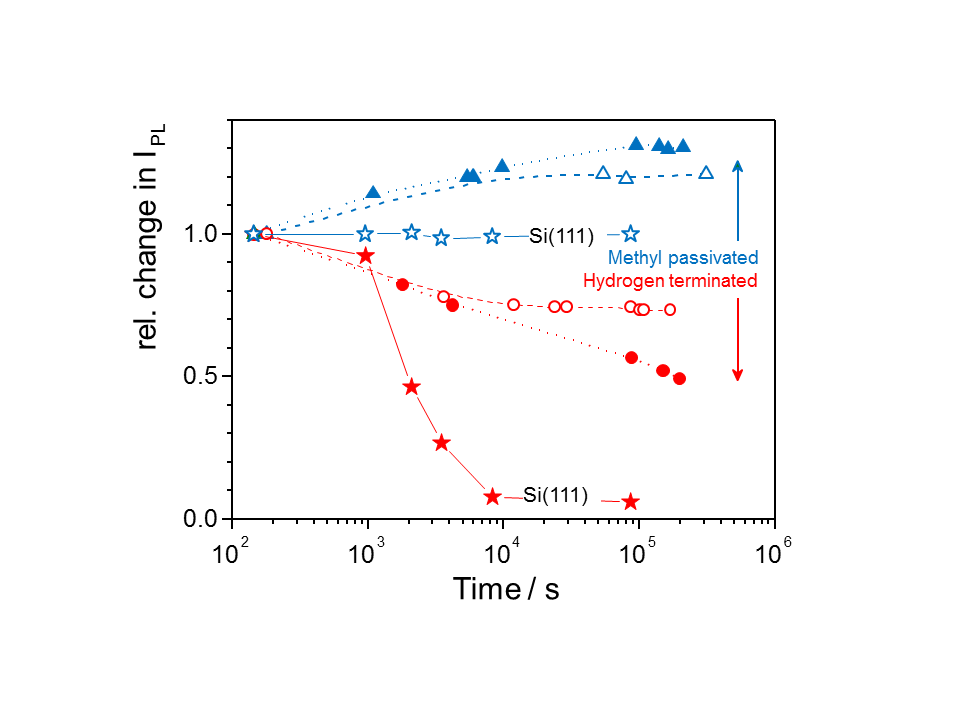Institut Silizium-Photovoltaik
Organische Emitter für Silizium Solarzellen
Organic materials (molecules or polymers) are used to replace the a-Si layer in the a-Si/c-Si heterostructure solar-cell working as emitter and hole conductor. The deposition of the organic materials on the Si absorber is performed by (electro-)chemical methods or spin-coating techniques. Different types of planar and structured silicon substrates (c-Si, poly-Si, µc-Si, and Si nanostructures in different sizes) are used as absorber materials (see Fig. 1), which require a special surface passivation [1].
This work has been started as a subtopic within the framework of the “Energie Allianz” Project of the HZB together with the universities of Potsdam and Berlin (FU and HU) [2].
The best long-term passivation in ambient air was obtained by performing an electrochemical methyl-grafting of the hydrogen terminated Si surface of either flat Si(111) or Si-NW surfaces (see Fig. 2) by use of methyl-Grignard compounds [1].

Fig. 2: Relative change in PL intensity of H-terminated Si nanowires and flat Si(111) surface (solid and open red circles, and solid red stars), and of the subsequently methylated Si nanowires and flat Si(111) surface (solid and open blue squares, and blue stars).
Up to now, efficiencies of 9.6% have been achieved by using planar c-Si (n-type) wafers and spin coating of P3TOT (see Fig. 3) [4].
Fig. 3: left: Structure of the silicon hybrid solar cell with a 40 nm thick polymeric layer; right: I-V curve of the cell under illumination (AM 1.5G, 100mW/cm2) with P3HT: Poly-(3-hexylthiophene-2,5-diyl), P3DOT: Poly-(3-[3,6-dioxaheptyl]-thiophene) and P3TOT: Poly-(3-[2,5,8-trioxanonyl]-thiophene).
references
[1] Electropolishing and passivation of Silicon Nanowires towards hybrid interfaces; Hänisch, J.; Klimm, C.; Rappich, J.; Electrochimica Acta 226 (2017) 46-52.
[2] a) Electrical and photoelectrical properties of P3HT/n-Si hybrid organic–inorganic heterojunction solar cells; Brus, V.V.; Zellmeier, M.; Zhang, X.; Greil, S.M.; Gluba, M.; Töfflinger, A.J.; Rappich, J.; Nickel, N.H.; Organic Electronics 13 (2013) 3109-3116.
b) Enhanced stability of P3HT/poly-crystalline Si thin film hybrid solar cells; Zellmeier, M.; Kühnapfel, S.; Rech, B.; Nickel, N.H.; Rappich, J.: Physica Status Solidi A 213 (2016) 1904-1908.
[3] In Situ PL and SPV Monitored Charge Carrier Injection During Metal Assisted Etching of Intrinsic a-Si Layers on c-Si; Greil, S.M.; Rappich, J.; Korte, L.; Bastide, S.; ACS Applied Materials & Interfaces 7 (2015) 11654-11659.
[4] Side chain engineering of poly-thiophene and its impact on crystalline silicon based hybrid solar cells; Zellmeier, M.; Rappich, J.; Klaus, M.; Genzel, C.; Janietz, S.; Frisch, J.; Koch, N.; Nickel, N.H.; Applied Physics Letters 107 (2015) 203301/1-4.
